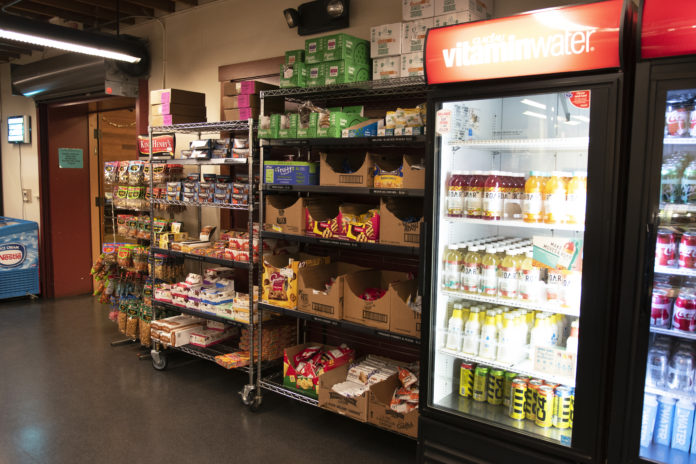
During winter break, Occidental’s campus remains open for select students, including members of the men’s and women’s basketball and swim and dive teams. Due to the lower volume of patrons and repairs to be made to the Marketplace facilities, the college is only able to keep the Cooler open, according to Associate Director of Campus Dining Robert Starek. However, the stagnant menu and limited hours of the Cooler left many athletes unsatisfied, according to swimmer Emily Driscoll (sophomore).
“Personally, I would try to eat out sometimes just because the Cooler’s all right, but for three meals a day for three and a half weeks, it’s not ideal,” Driscoll said. “I would eat [off campus] when I could, but also that started getting a little expensive, so it was a little frustrating.”
According to Starek, deciding how to serve students on campus during break is a complicated process that fluctuates from year to year.
“There’s any number of projects that need to take place to keep the facilities up to par, so the best time for those types of projects to be done are when students are away,” Starek said.
While he knows athletes would prefer to have the Marketplace, Starek said breaks are the only times when major repairs can take place. According to Starek, the Marketplace’s dishwashing machine and a portion of the kitchen floor were replaced over the winter of 2018. In 2019, the elevator in the Johnson Student Center (JSC), which goes between food storage downstairs and the kitchen upstairs, was modernized.
Basketball player Raveena Dhiman (sophomore) said during the break, the nutritional value of the Cooler’s food was her primary concern.
“For athletes, I don’t think it’s super nutritional, just because the Cooler is more of a fast food dining hall,” Dhiman said. “All of the options are greasy and pretty carb-heavy.”
According to Driscoll, athletes got creative trying to make the Cooler menu work for their diets.
“My go-to thing was a grilled chicken teriyaki bowl with the vegetables that they usually put in the veggie philly,” Driscoll said. “But when I did that, they would charge me for an entire teriyaki bowl as well as the veggie philly. So they would charge me for two meals, which ended up being two-thirds of my meal plan for the entire day.”
Driscoll said ordering nutritious — and expensive — meals at the Cooler was not sustainable due to the way meal money was distributed to athletes. According to women’s basketball coach Anahit Aladzhanyan ‘07, students get $28 of sponsor money each day, which card office employee Collin Mazeika (junior) said does not roll over from day to day. Additionally, Driscoll said athletes using sponsor money do not receive the 50 percent off discount students using their own meal plan money do.
According to Dhiman, the women’s basketball team was on campus for four weeks before most students arrived Jan. 18. Dhiman said there was a period during this time where all dining facilities were closed on campus.
Cooler hours over the break are partially dependent on employee shifts, according to Starek.
“We have employees that are taking advantage of vacations — we do have limited staff,” Starek said. “We want to make sure we’re maximizing our labor. We don’t want to have a facility open for a period of time that requires unnecessary staff.”
According to swimmer Sarah Nelson (sophomore), when the Cooler was closed, athletes received their $28 in cash.
“We were given a lump sum on the 30th [of January],” Nelson said. “It’s super inconvenient for us who are stuck, most of us without cars, walking places.”
Starek said having facilities open earlier or later over break would require there to be more than one shift in a day. Overlapping shifts would only allow the Cooler to stay open one hour earlier or later. Winter break shifts are eight hours for full-time employees, and consist of one supervisor, two cooks, a cashier and a barista, according to Starek.
Cooler hours did not always align well with practice hours. Basketball and swim practices sometimes ended as late as 6 p.m., which is when the Cooler stopped cooking over the break, according to Dhiman, Driscoll and Nelson.
Nelson said many athletes used their own money to supplement Cooler food with off-campus options.
“For those that had the financial means, they refused to eat at the Cooler, which was great for them because they could afford it, but other people couldn’t necessarily do that,” Nelson said. “It was tough trying to get adequate food without feeling like you’re just eating processed snack after processed snack.”
Many students used UberEats, according to Nelson. She said she had a hard time making the money last and resorted mostly to fast food.
Starek said Campus Dining is willing to collaborate with students and coaches and use the Marketplace facilities to make dishes not typically offered during winter break. The dishes could then be transferred to the Cooler without fully opening the Marketplace and disrupting repairs.
Driscoll said she does not know if there has been any communication with coaches or Campus Dining from athletes about their dissatisfaction with the Cooler, but she hopes the dining options available to athletes over winter break will change in the future.
“We are varsity athletes here. We’re trying to represent our school, and nutrition is a really big part of that,” Driscoll said. “I think the school should be doing a little more at least to give us some healthier options so that we can be at our best.”
![]()


































